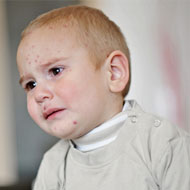- General Articles
- General Pregnancy Questions
- Baby Growth
- Pregnancy Diet
- Miscarriage
- During Pregnancy
- Twin Pregnancy
- Toddler Meals
- Home Remedies During Pregnancy
- Breastfeeding
- Pregnancy Week By Week
- Pregnancy Tests
- Ectopic Pregnancy
- Pregnancy Signs and Symptoms
- Pregnancy Stages
- Potty Training
- Fetal Development
- Preschooler
- Postpartum Depression
- Toddler Illness
- Baby Care
- After Pregnancy
- Molar Pregnancy
- During Delivery
- Beauty and Style
- Pregnancy Clothing
- Preconception
- Fertility
10 Facts Related To Sudden Infant Death Syndrome
Sudden Infant Death Syndrome, commonly known as SIDS, can be described as the sudden death of a baby who is below the age of 1 year. The infant's death is neither predicted by medical experts, nor can it be explained after a detailed investigation and a thorough forensic autopsy. This syndrome can also be referred to as crib death or cot death.
SIDS usually occurs when babies swallow or cough up the fluid that enters their airways. Many parents believe that the risks of SIDS are higher when babies sleep on their backs. However, there are no studies to indicate that babies sleeping on their backs are more likely to choke in their sleep and suffer from sudden infant death syndrome.
Children can suffer from SIDS if they sleep on their side.
Given below are a few sudden infant death syndrome facts:
- A child is more likely to suffer from sudden infant death syndrome during the colder months of the year as compared to the summer or spring months.
- A majority of the deaths related to SIDS take place when the babies are between the ages of 2 months and 4 months.
- For reasons unexplained, babies of African American descent are twice as likely to die of this syndrome as compared to white babies.
- Most SIDS cases occur in children when they are asleep, which is why the condition is known as crib or cot death. However, studies indicate that sleeping in a crib or a cot does not lead to sudden infant death syndrome.
- SIDS causes a child to die suddenly for no apparent reason. There are no signs of the child suffering because of this syndrome.
- SIDS happens to be the leading cause for death in children between the ages of 1 month and 1 year.
- The risk of SIDS in babies drops drastically after the age of 6 months.
- There are no symptoms to warn parents or caregivers about SIDS. The child's death cannot be predicted by anybody, not even a doctor.
- This syndrome is seen more often in boys than girls.
- Vaccinations and medicines cannot cause or increase the risks of SIDS in babies. Children should always receive their vaccination shots on time, as recommended by a pediatrician.
There is no way in which you can make sure that your baby will not be a victim of SIDS though you can take steps to reduce the risks of this syndrome. These include:
- Placing the baby on his back during bedtime or even a nap time
- Making sure that the baby sleeps on a firm surface with a well-fitted sheet
- Keeping any soft objects or loose bedding away from the baby's bed
- Maintaining a cool and comfortable temperature in the baby's room
It is important for parents of all infants and little children to learn how to give CPR, as it could save a baby from SIDS. Speak to your pediatrician for any more steps you can take to reduce the risks of SIDS.
Read more articles from the Postpartum Depression Category.



 7 Must-Haves Before Your Baby Arrives
7 Must-Haves Before Your Baby Arrives Bonding Games for Babies
Bonding Games for Babies DIY Baby Bath Towel Apron
DIY Baby Bath Towel Apron Common Late Pregnancy Fears
Common Late Pregnancy Fears